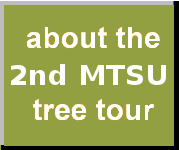
|

|

|
An individual instance of Cercis canadensis (eastern redbud)
Permanent unique identifier for this particular organism:
http://bioimages.vanderbilt.edu/mtsu/31
Notes:
Description and Adaptation
Eastern redbud is a native, perennial, deciduous tree which grows 15 to 30 feet tall and spreads 15 to 25 feet. Older trees generally resemble a vase shape. This tree is a member of Fabaceae or pea family. Eastern redbud is found throughout the lower Great Plains and eastern United States. Eastern redbud is usually one of the first trees to bloom in spring. Pink to reddish purple flowers are grown on old twigs, branches, and trunks. Flowering occurs in March to May before leaf growth. After bloom, the leaves begin growing and gradually turn dark green. When mature, the alternately arranged leaves are about four inches long, four inches wide and heart shaped with prominent venation. The twigs are slender, spreading, zigzag with short or dark brown knotty spurs. Eastern redbud produces clusters of flat green pods (~3.5 inches long, ~0.5 inches wide) that change to brown when mature. Each pod contains four to ten small hard black or brown seeds. Eastern redbud occurs as scattered trees or small populations. It is an understory species in open woods and is found on moist, loam or sandy soils in valleys or bottomlands. Usually this tree is more numerous on south facing slopes with more sunlight. Eastern redbud grows on a wide range of pH; however, it grows best on soils with a pH of 7.5 or above. It is not found on inundated sites, poorly aerated soils, or coarse sands. The tree is fire tolerant and root sprouts after fire.
Uses
The eastern redbud is widely planted as an ornamental tree for its striking spring display of plentiful pink flowers and its heart-shaped leaves.
The Henry's elfin butterfly (Callophyrus henrici) and hummingbirds utilize eastern redbud for nectar. Honeybees use the flowers for pollen.
Native Americans boiled the bark to make tea to treat whooping cough. Dysentery was treated using an astringent from the bark. The roots and inner bark were utilized for fevers, congestion, and vomiting. The flowers can be fried and eaten.
Whitetail deer browse the foliage and twigs during the spring and summer. Squirrels occasionally eat the buds, bark, and seed. Bobwhite quail and songbirds eat the seeds. However, for the animals which utilize eastern redbud, it is considered a less desirable or emergency food. Livestock will infrequently graze on the foliage and twigs.
Establishment
Eastern redbud has a hard seed coat and dormancy. The seed are dispersed by wind and animals. Very young seedlings which have sprouted around parent trees are easily moved when they are small. Eastern redbud develops a deep taproot that grows quickly the first few years under conducive conditions.
References
Brakie, M. (2010). Plant fact sheet for eastern redbud (cercis canadensis). Retrieved from http://plants.usda.gov/java/factSheet

|

|
|
Load database and switch to thumbnail view
Use this stable URL to link to this page:
http://bioimages.vanderbilt.edu/mtsu/31.htm
This particular organism is believed to have managed means of establishment.
This organismal entity has the scope: multicellular organism.
Identifications:
Cercis canadensis
L.
sec. Wofford Chester 2002
common name: eastern redbud
family: Fabaceae
Identified 2016-03-13 by Patrick Phoebus
Location:
Military Memorial, Keathley University Building, Rutherford County, Tennessee, US
Click on these geocoordinates to load a map showing the location: 35.8478°, -86.3658°
Coordinate uncertainty about: 10 m.
Altitude: 196 m.
Location calculated as average of its images' coordinates.
Occurrences were recorded for this particular organism on the following dates:
2016-03-13
2016-04-27
The following images document this particular organism.
Click on a thumbnail to view the image and its metadata. Load database and enable navigation by taxon and organism.